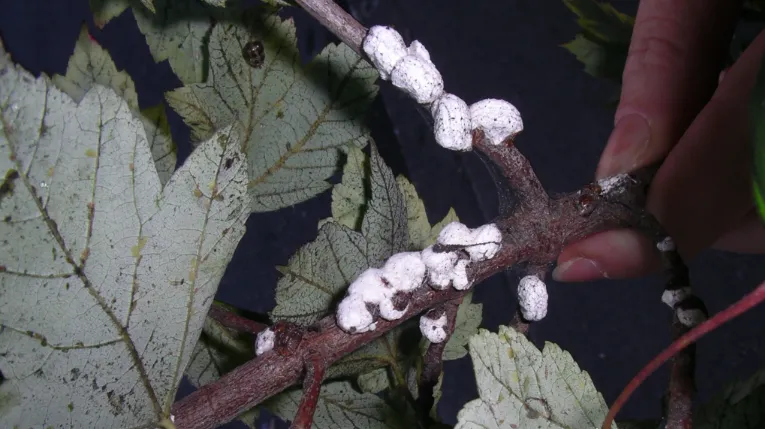
Think It’s Just Tree Fluff? It Might Be a Deadly Scale Infestation
Think It’s Just Tree Fluff? It Might Be a Deadly Scale Infestation
Meet the Villains: What Are These Scales?
Your trees might look fine from a distance, but take a closer look—those little white patches on the twigs or bark might be more than just “tree dandruff.” If you live in Utah, there’s a high chance you're seeing Cottony Maple Scale or Cottony Cushion Scale, two common—but dangerous—tree pests.
These pests are known for blending in, reproducing fast, and quietly draining your tree’s life.
1. Cottony Maple Scale
Looks Like: Little white cotton balls stuck to twigs—think popcorn on a string
Favorite Targets: Silver maples (but also attacks other hardwoods)
Season to Watch: Late spring through summer
Signs of Trouble: Honeydew on your car, sidewalk, or windows. Black sooty mold forming on leaves. Premature leaf drop.
How it works:
Cottony maple scale females lay up to 1,000 eggs in those fluffy sacs. Their babies (called crawlers) settle under leaves and suck the life out of your tree. While one or two scales may not be a big deal, an unchecked infestation can cause real damage over time, including twig dieback and stunted growth.
2. Cottony Cushion Scale
Looks Like: Cottony white blobs under branches or on bark
Favorite Targets: Ornamental plants like magnolias, boxwoods, roses, and even citrus
Season to Watch: All year (overlapping generations means no break)
Signs of Trouble: Dense white egg sacs, yellowing leaves, sticky honeydew everywhere
Why it’s worse:
Unlike cottony maple scales, this one breeds year-round. Multiple generations pile on each other, sucking sap nonstop. It spreads fast and produces tons of honeydew, which attracts ants and causes black mold. It can quickly turn into a sticky, stinky mess.
More Than Just an Eyesore: The Hidden Damage
Too many people dismiss these pests because they look like fluff. But what’s really happening under the surface?
Inside the tree:
Scale insects pierce through the tree’s surface and suck out nutrients 24/7. Over time, this weakens the vascular system and can cause internal dieback.
On the surface:
Heavy infestations stop new leaf growth, kill off branch tips, and turn once-beautiful trees into sickly skeletons.
Around the tree:
Their honeydew becomes a breeding ground for black mold, attracts wasps and ants, and causes other plants beneath the tree to suffer from limited sunlight and airflow.
In other words—this isn’t just about some sticky stuff. It’s about the health of your entire landscape.
What Makes Scale Insects So Hard to Deal With?
Here’s what most people don’t realize:
They don’t look like bugs.
Scale insects often just look like fluff, mold, or fungus. Most are wingless, eyeless, legless blobs.
They don’t move once they settle.
Once they latch on, they stay in one spot for life—feeding through long needle-like mouths.
They hide on the undersides of leaves and deep bark cracks.
That means they’re missed during routine yard checks.
They reproduce like crazy.
One cottony maple scale female lays up to 1,000 eggs. Cottony cushion scales can keep breeding year-round.
They bring other problems with them.
Their sugary waste (called honeydew) attracts ants and fungus, especially black sooty mold, which spreads fast.
The Pain You’ll Notice (Besides the Bugs)
Sticky Mess: The sugary waste (honeydew) from these insects drips on everything—cars, decks, furniture, and walkways.
Mold: The black sooty mold that follows turns your trees and anything below them into an ugly mess.
Stunted Trees: These bugs steal nutrients. Over time, branches weaken, growth slows, and the tree loses its vigor.
Increased Disease Risk: Weakened trees are more vulnerable to pathogens, borers, and Utah’s extreme weather.
Frustration: Even if you try spraying something yourself, the bugs keep coming back.
How to Spot Trouble Before It’s Too Late
Use this quick checklist:
Do your trees have white, fuzzy egg sacs stuck to branches or leaf undersides?
Is there sticky residue on your patio, furniture, or car?
Are leaves dropping early or turning black with sooty mold?
Do you see ants crawling all over your tree?
Have you noticed stunted branch growth or dead twigs?
Here’s the Real Problem
Most homeowners don’t notice scale insects until the damage is done. They hide on the underside of leaves or along branches and look more like fungus or mold than bugs. And while you might be tempted to spray chemicals, that’s not always the answer.
Bad timing = wasted effort
Wrong insecticide = zero results
Spraying too early or late = no control at all
DIY jobs = damage to your tree or local ecosystem
What You Can Do (and What We Can Do for You)
For Cottony Maple Scale:
Timing is everything. The best time to treat is after eggs hatch (early to mid-July).
Don’t spray too early. You’ll miss the crawlers.
We recommend insecticidal soap or horticultural oils, applied with precision.
For Cottony Cushion Scale:
Because it breeds all year, we use a targeted, year-round care plan.
We also monitor for natural predators like ladybugs, which can keep populations down naturally.
In tough cases, we use professional-grade treatments designed for these soft scales.
Why Choose Utah Tree Care Pros?
ISA Certified Arborists who know exactly how to identify and stop scale insects.
Local Experts trained to understand Utah’s unique tree challenges.
Custom Treatment Plans based on your property, tree species, and infestation severity.
No gimmicks. Just science-based, long-term care to keep your trees healthy and your property safe.
Don’t Wait for the Sticky Mess
The sooner you catch a scale infestation, the easier it is to manage. Whether you’re seeing symptoms or just want peace of mind, our team is here to help.
Call (801) 870-0164 or click “Request Consult” to schedule your expert evaluation today.
We’ll protect your trees from root to canopy—because healthy trees start with expert care.